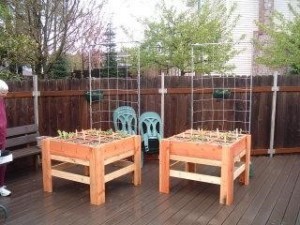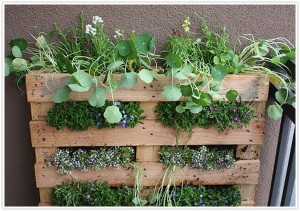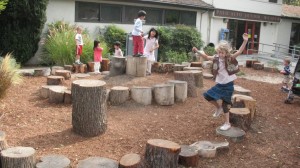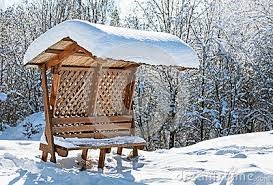BLOG POST 3
Brainstorming Ideas:
During a group meeting, members discussed various ideas and arrived at an unanimous consensus on the ideas. These ideas are presented below with pictures.
1) Elevated Vegetable Garden
Much like below, but perhaps larger and with the possibility of one or two plexiglass sides and removable plexiglass cover.

retrieved from: http://media.merchantcircle.com/22231381/Raised%20Vegetable%20Garden_full.jpeg
Estimated Cost Breakdown:
Wooden Frame: ~$200 for 8ft x 8ft patch
Plexiglass: ~$200 for cover; ~$100 per side
2) Living Wall
Wooden Lattice in front of current fence with vines growing in between possibility of integrated herb-boxes. Alternatively, grow herbs suspended from lattice;
Retrieved from http://camillestyles.com/wp-content/uploads/2011/11/herb3.jpg
and http://claytonditzler.zenfolio.com/img/s2/v60/p1236821608-3.jpg respectively
Estimated Cost Breakdown:
Pallets: (potentially free if used?/quite cheap)
Wooden Lattice: ~$20 per 8ft²
Flowerboxes: ~$10-$20 per piece
3) Obstacle Course
Following contours of asphalt path. Wooden stumps would be secured by digging them in deep enough; potential to integrate tires into course. *Stumps no higher than 6 inches
Retrieved from: http://www.play-scapes.com/wp-content/uploads/2008/10/palo-alto-zoo-playground-3-1024×574.jpg
Estimated Cost: $8-10 per stump (i.e. x 25)
≈$250
4) Covered Bench
For parents to sit in the shade and children to climb around on
Estimated Cost: $8 per slab of wood
40 slabs of wood – aprox. $320
Techniques Used to Choose Ideas and Reasons for Final Choice:
The main factors considered in choosing an idea were:
- Cost
- Materials
- Safety
- Client preference
Upon brainstorming ideas, the client was contacted to propose the aforementioned ideas.
Although the obstacle course with logs was the most expensive option, the client informed the team that the logs would be donated by an external source which means the “materials” would be readily available at no “cost”. Thus, the options to build an obstacle course results in the cheapest option, $0. Also, the client was particularly keen on an obstacle course as this would enhance the children’s balance and jumping skills.
The client was not as keen on the other option, thus other ideas failed the “client’s preference” criteria and were discarded.
Since the “safety” criteria was a concern considering children might fall and get hurt, the team decided to have little spacing between logs to ease movement as well as place the obstacle course at a reasonable distance from the concrete pavement to minimise risk of injuries.
Timeline and Milestones:
January 22: CBEL Introduction Seminar
January 23: Group meets Mentor, Roles Delegated to group members
February 3: Group meeting at Keiser to discuss project
February 12: Skype meeting with the client
February 28: Group members visit play grounds in respective neighbourhoods to get ideas
March 2: Group meet client and visits site, client proposes ideas
March 10: Group meeting to discuss final ideas of project. Elevated vegetable garden, living wall, obstacle course and benches proposed
March 10: Skype meeting with client, client shares opinion and suggestions
March 11: Design options with cost breakdown sent to client
March 20: Group meeting online
March 24: Site visit and client meeting
March 28: Final report submission to client





Through this post, you have present the basic ideas of this project. I like the ideas of Elevated Vegetable Garden and Living Wall. However, for the Obstacle Course part, maybe we should pay more attention to the safety part. It would have potential risks for causing hurts. We could take some measures to protect kids.
I’m glad we also give predicted price for each part, that is a very important criterion to choose our potential plans.